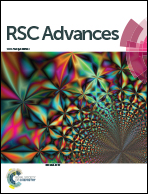Synthesis and evaluation of cationically modified poly(styrene-alt-maleic anhydride) nanocarriers for intracellular gene delivery†
Abstract
Intracellular gene delivery properties of styrene-alt-maleic anhydride based graft co-polymers embedded with various cationic moieties were analyzed. Quaternary nitrogen units were grafted to the polymer via aromatic (quaternized isonicotinic acid), aliphatic (glycidyl trimethyl ammonium chloride) and cyclo aliphatic (quaternized piperazine) molecules. Primary/secondary amine-grafted polymers were obtained by conjugating L-arginine and spermine. These amphiphilic graft copolymers readily formed core shell type nanoparticles of size < 100 nm. Cytotoxicity, haemo-compatibility, endosomal rupturing properties, polyplex formation and resistance to DNase degradation were evaluated for all the polymeric derivatives, and found to have a strong correlation with the nature of the cationic moieties. The cytotoxic potential of the cations was in the order: quaternized piperazine > spermine > quaternized isonicotinic acid, L-arginine and glycidyl trimethyl ammonium chloride. Excellent endosomal rupturing efficiency (% haemolysis at pH 5.5) was observed for quaternized isonicotinic acid (∼86%), spermine (∼78%) and L-arginine (∼73%) grafts. Polyplexes of the quaternized derivatives showed reduced DNase resistance probably due to electrostatic repulsion of carboxylic side chains. L-Arginine and spermine grafted nanocarriers exhibited efficient DNA complexation and DNase resistance, and hence were evaluated for transfection efficiency in MCF-7 cells. The spermine graft depicted a 1.45 fold higher transfection efficiency than the positive control (branched polyethyleneimine, 25 000 kDa), and the L-arginine graft achieved comparable efficiency to that of the control. These amphiphilic nanocarriers show promising potential for in vivo gene delivery applications due to their lower cytotoxicity, pH responsiveness, large scale production feasibility and ease of chemical modification.


 Please wait while we load your content...
Please wait while we load your content...